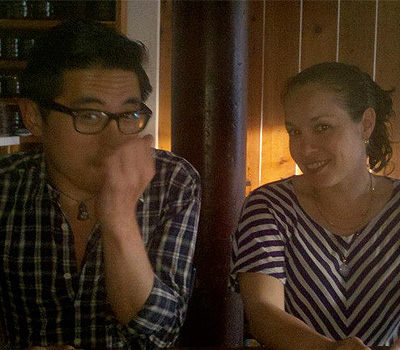Vinny Eng started as a runner at Bar Tartine, becoming friends with former beverage director Alex Fox. Fox mentored him so well that Chad Robertson, Bar Tartine’s owner, promoted Eng when Fox moved on. He’s been co-curating the beverage program with Kim Watson-Jew (both pictured below) since December 2011, chasing down wines that have what he refers to as heritage or lineage. That’s led to a list rich in curiosities.


How did you first get excited about wine?
It dawned on me when I was sitting with Oliver McCrum at a tasting—I was a few months into my tenure here. We started talking about the beauty and ageability of fiano, and had this big conversation about how vivid a grape fiano can be and how it can evolve over time. It really started to click—the depth and heritage to this craft. And I just started to see it. I had the great honor to taste with Wells Guthrie [of Copain]—to receive the knowledge and passion from Wells. Or Helen Turley—hearing her talk about these remarkable old vineyards in Lodi. Or someone like Scott Schultz of Jolie-Laide, who made a small production of trousseau gris just out of curiosity. There are all these overlooked grapes from California, and people are giving them a second glance to see what they offer. I started aggregating a few very beautiful stories.
How do you describe what the kitchen at Bar Tartine is doing, and how do you put together a wine program that complements that?
A lot of people ask: What kind of cuisine is this? At first people pegged us as Hungarian because of the eastern European techniques. But really we’re just a restaurant in San Francisco that’s interested in curiosity.
The food here focuses on traditional techniques that express a heritage of food making—like bread. And pickling, preserving, drying. So to mirror that, heritage, lineage and storytelling have always been features of our beverage program here.
I’m interested in California producers who have spent time in the Old World. Like Ted Lemon, an American who made wine in Burgundy, and yet his passion is California. Or Graham Tatomer, who spent time working at Knoll, but now he’s making riesling and grüner on the Central Coast. Or Matthew Rorick from Forlorn Hope, who is making some of the most uniquely expressive wine I’ve had in a long time. He makes an alvarelhao called Suspiro del Moro—it’s beautiful and really California and great with food.
How do you provide people with familiarity, but in a different context? It’s been fun to put together a well-priced list that invites people to take a little leap.
A Turley white zinfandel was your top by-the-glass pour. Can you explain that?
I love rosé. I could drink rosé for days. Christina Turley had become a frequent diner at the restaurant, and I was exploring the notion of lineage on the list. There aren’t a lot of female grower-producers. It became a point of curiosity for me, and an opportunity to ask: Do you know of any female winemakers who might have something really great and really fun that I should taste? Christina said: “I have two words for you, white zin.” She tasted me on it. It’s this beautiful dry rosé made from zinfandel that was Christina’s brainchild. She talked to her father [Larry Turley] and the winemaker [Ehren Jordan], and they decided to do it. They called it Tongue in Cheek White and made it really accessible with the pricing—and I’m happy to pour people a glass of white zin, so they can have a different experience of what it means to be white zin.
What’s been a more recent Old World discovery for you?
Because a lot of our flavors are Eastern European, it’s been fun to work with Blue Danube [Wine Company], and support their search. The Piquentum Istria Teran Rouge they bring in [from Croatia] is one of the most beautiful wines I’ve had in a long time—violets on the nose, a spice that can rival any zin. We sell that by the glass, and people have just inhaled it. It’s a slightly different profile than traditional Italian or French wines.
You note that wine only accounts for about one third of your beverage sales—what’s it like these days to sell wine in a climate where microbrews and cocktails continue to gain traction?
It’s funny—sometimes the better pairing is beer. We’re in this corridor with Abbot’s Cellar and Monk’s Kettle and St. Vincent, places where people take beer seriously. Plus, we have a house beer that we brew with Tartine bread yeast—it’s fun to have that additional toy to play with. This is rustic food, and beer and wine both integrate with that experience in a powerful way. A lot of the food here hits the mid-palate, it’s rich in flavor. And what better umami bomb than beer?
Longtime senior editor at Wine & Spirits magazine, Luke now works for the Stanford Technology Ventures Program.
















